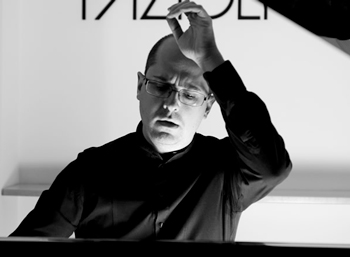by Daniel Hathaway

A year ago, Plano accepted a position at Boston University, and he and his wife and three daughters moved to the United States. In a telephone interview from Boston, Plano noted that the transition has been both difficult and rewarding. “I knew the United States very well, but I never lived here for more than a couple of weeks at a time,” he said.
“It was a big difference. My kids went to school without knowing any English, so at first it was very hard, but now they’re doing their homework in English and we feel that we’ve adjusted.”
At BU, Plano teaches a studio of sixteen students, “not so different from what I had in the conservatory in Italy, though now I also have faculty meetings, which I didn’t before. I’m finding pretty much the same level of students, but we don’t offer doctorates in Italy, so I’m very excited to be teaching older pianists,” he said. Plano is glad that BU encourages its music faculty to continue performing. “I’m trying really hard to combine my two careers of teaching and concertizing.”
For his Tri-C performance, Plano has chosen what he believes to be a balanced program — “classical pieces nobody’s heard of and pieces that depart from the classical style.” The first category includes five selections from Franz Liszt’s Harmonies poétiques et religieuses. “I had the opportunity to record the entire collection last year for Decca,” he said, adding that that was the first performance of the work to be recorded in 50 years. “I always wanted to record this music because I really love it — it’s very different Liszt from the Hungarian Rhapsodies or the Sonata that everybody plays.”
Plano said that for Cleveland he next chose two pieces to demonstrate different styles: Heitor Villa-Lobos’ “Impressões seresteiras” from Ciclo brasileiro, and Alberto Ginastera’s Suite de danzas criollas. “Villa-Lobos and Ginastera borrow so many themes from popular culture. The first work is in the Brazilian composer’s thick piano style with many notes, chords, and appoggiaturas, but also uses a big Latin tune that stays in your mind. It makes a great combination with the Ginastera. Argentine culture is very different, but both pieces share a South American feeling.”
Sunday’s concert will end with the premiere of Roberto Plano’s own solo piano arrangement of Gershwin’s Rhapsody in Blue, an adaptation that features at least a few of the pianist’s own embellishments. “At first, I wanted to include only what Gershwin wrote, but I couldn’t resist adding some little elements like secondary voices. I’ve done the concerto so often that I know the orchestra part very well, and even though I can’t imitate those sounds, I’ll try to use my imagination.”
Plano added that there are pitfalls for a pianist used to playing the orchestral version of the concerto. “It’s hard for me not to stop playing when the orchestra usually takes over. I keep telling myself: you have to play the whole piece!”
I ended our conversation by asking Roberto Plano what winning his gold medal in the Cleveland Competition did to launch his career. “Without that I wouldn’t be teaching at BU for sure,” he said. “It opened doors for me in the United States in an incredible way.”
But at the time, Plano wasn’t sure he wanted to win the contest. “I was just happy to be selected as a competitor, and I would have been happy with second prize. But round after round I realized that I was going farther and farther. I was very much afraid of winning it because I knew it would change my life, and I didn’t know if I was ready. But everything started from there.”
Published on ClevelandClassical.com October 10, 2017.
Click here for a printable copy of this article



